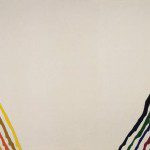Remembering the Washington Gallery of Modern Art
By • July 26, 2011 One Comment 5569

If the Washington Gallery of Modern Art were mentioned in conversation, most would not register the name. It would likely be assumed that whomever speaking had been referring to any number of alternative DC art institutions – the East Wing of the National Gallery, the Hirshhorn, the American Art Museum, The Phillips Collection (famously America’s first museum of modern art). However, though few may remember it now, the Washington Gallery of Modern Art (WGMA), while only open for seven short years in the 1960s, was a major force in establishing the District in the forefront of contemporary art.
After the mid-century shockwave of painters like Jackon Pollock, Mark Rothko, and Willem de Kooning, who had together incinerated centuries of artistic boundaries and limitations, the direction of fine art was aberrantly unclear to many. With such an undefined and endless landscape of possibilities, painting became an entirely new, somewhat chaotic domain, ushering in a wide influx of late abstract expressionism and countless subsequent movements and conceptual innovations.
New York City, as the perpetual colossus of world culture, had claimed near authoritarian control of the fast-paced society of modern art. Prophetic gallerist Leo Castelli had built a personal infantry of loyal artists led by Jasper Johns and Robert Rauschenberg. The MoMA was acquiring amplitudes of new work and declaring the immediate genius of new artists almost as soon as they emerged from school – Frank Stella became among the elite museum acquisitions at the age of 23. Most major contemporary artists were working out of the city. There didn’t seem to be much noise coming from anywhere else.
On October 28, 1961, the WGMA opened its doors, bringing serious attention and notoriety to Washington’s art community, championing this new era of fine art and introducing one of DC’s own art movements into the vernacular.
Co-founded by Alice Denney – matron of the Washington avant-garde who went on to found the wildly successful community darling, Washington Project for the Arts – the gallery brought a wealth of influential American artists and works to the District, while garnering national attention to working artists within the city.
Incorporated as a nonprofit organization, the gallery resided in Dupont Circle, converted from the large carriage house of the headquarters of the Society of Cincinnati. (The Society of Cincinnati, founded in 1783 by the officers of the Continental army, is still the nation’s oldest patriotic organization, dedicated to preserving the memory of the American Revolution.) The gallery’s first director, Adelyn Breeskin, had just recently retired as director from the Baltimore Museum of Modern Art.
One of the gallery’s earliest exhibitions, which caught the attention of the art community at large, was the Franz Kline Memorial Exhibition in October 1962, put up almost immediately following the artist’s death in May of that year. Denney was curator of the exhibition.
The gallery’s collection included works from Ellsworth Kelly, Robert Indiana, Marcel Duchamp, and a cultivation of contemporary American art movements from the ‘50s and ‘60s. Late abstract expressionism, color field painting, minimalism, and pop art were all represented. Their “Popular Image Show” in 1963 brought to the District many of the most highly prized contemporary artists of the day; Robert Rauschenberg, Jasper Johns, George Brecht, Claes Oldenburg, and James Rosenquist among them.
At the gallery’s turbulent “Pop Festival,” also in 1963, composer John Cage performed with the Judson Dancers, and Rauschenberg debuted his now famous performance piece, “Pelican.”
However, what propelled the WGMA to the forefront of the artistic community was its 1965 breakthrough show, “Washington Color Painters.” Touring around the nation, the exhibition introduced the art world to a group of local DC painters now known as the Washington Color School, which included artists Kenneth Noland, Gene Davis, and Morris Louis. With bold, thick lines of colors, harmonious compositions, and clean shapes, the Washington Color Painters created iconic reflections of Matisseian joy and the subconscious melancholy behind all beauty.
Towards the mid 1960s, with the expansion of the National Gallery of Art, a more active contemporary arts program at the Corcoran, and the loudly touted development of the Hirshhorn Museum, the WGMA, small and relatively modest, lost its unique foothold in the Washington art community. The Oklahoma Art Center, now the Oklahoma City Museum of Art, purchased the WGMA’s 154-piece collection in September 1968 and the gallery shut down.
The WGMA came and went like many of the art movements of its time: riveting, innovative, and short-lived. The Hirshhorn still frequently displays pieces by the artists of the Washington Color School, including masterworks by Noland and Louis. While the gallery is long since closed, it brought life and national attention to Washington’s art community when it was in dire need. And in the richness of the DC art community, the echoes of its spirit can still be felt today.
- Gene Davis, “Hot Beat” (1964) | Photo courtesy of Tudor Place




I am looking for detail on an Exhibit by Frank Bruno in 1968 – do you have any suggestions? thank you